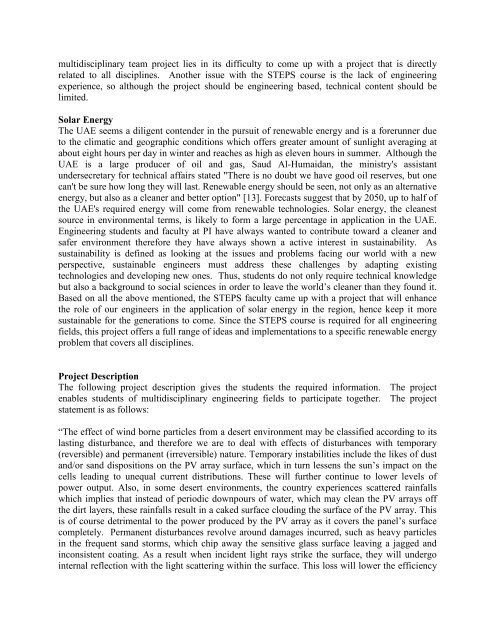Dr. Lisa Ann Lamont & Dr. Lana El Chaar The Petroleum Institute ...
Dr. Lisa Ann Lamont & Dr. Lana El Chaar The Petroleum Institute ...
Dr. Lisa Ann Lamont & Dr. Lana El Chaar The Petroleum Institute ...
You also want an ePaper? Increase the reach of your titles
YUMPU automatically turns print PDFs into web optimized ePapers that Google loves.
multidisciplinary team project lies in its difficulty to come up with a project that is directly<br />
related to all disciplines. Another issue with the STEPS course is the lack of engineering<br />
experience, so although the project should be engineering based, technical content should be<br />
limited.<br />
Solar Energy<br />
<strong>The</strong> UAE seems a diligent contender in the pursuit of renewable energy and is a forerunner due<br />
to the climatic and geographic conditions which offers greater amount of sunlight averaging at<br />
about eight hours per day in winter and reaches as high as eleven hours in summer. Although the<br />
UAE is a large producer of oil and gas, Saud Al-Humaidan, the ministry's assistant<br />
undersecretary for technical affairs stated "<strong>The</strong>re is no doubt we have good oil reserves, but one<br />
can't be sure how long they will last. Renewable energy should be seen, not only as an alternative<br />
energy, but also as a cleaner and better option" [13]. Forecasts suggest that by 2050, up to half of<br />
the UAE's required energy will come from renewable technologies. Solar energy, the cleanest<br />
source in environmental terms, is likely to form a large percentage in application in the UAE.<br />
Engineering students and faculty at PI have always wanted to contribute toward a cleaner and<br />
safer environment therefore they have always shown a active interest in sustainability. As<br />
sustainability is defined as looking at the issues and problems facing our world with a new<br />
perspective, sustainable engineers must address these challenges by adapting existing<br />
technologies and developing new ones. Thus, students do not only require technical knowledge<br />
but also a background to social sciences in order to leave the world’s cleaner than they found it.<br />
Based on all the above mentioned, the STEPS faculty came up with a project that will enhance<br />
the role of our engineers in the application of solar energy in the region, hence keep it more<br />
sustainable for the generations to come. Since the STEPS course is required for all engineering<br />
fields, this project offers a full range of ideas and implementations to a specific renewable energy<br />
problem that covers all disciplines.<br />
Project Description<br />
<strong>The</strong> following project description gives the students the required information. <strong>The</strong> project<br />
enables students of multidisciplinary engineering fields to participate together. <strong>The</strong> project<br />
statement is as follows:<br />
“<strong>The</strong> effect of wind borne particles from a desert environment may be classified according to its<br />
lasting disturbance, and therefore we are to deal with effects of disturbances with temporary<br />
(reversible) and permanent (irreversible) nature. Temporary instabilities include the likes of dust<br />
and/or sand dispositions on the PV array surface, which in turn lessens the sun’s impact on the<br />
cells leading to unequal current distributions. <strong>The</strong>se will further continue to lower levels of<br />
power output. Also, in some desert environments, the country experiences scattered rainfalls<br />
which implies that instead of periodic downpours of water, which may clean the PV arrays off<br />
the dirt layers, these rainfalls result in a caked surface clouding the surface of the PV array. This<br />
is of course detrimental to the power produced by the PV array as it covers the panel’s surface<br />
completely. Permanent disturbances revolve around damages incurred, such as heavy particles<br />
in the frequent sand storms, which chip away the sensitive glass surface leaving a jagged and<br />
inconsistent coating. As a result when incident light rays strike the surface, they will undergo<br />
internal reflection with the light scattering within the surface. This loss will lower the efficiency


